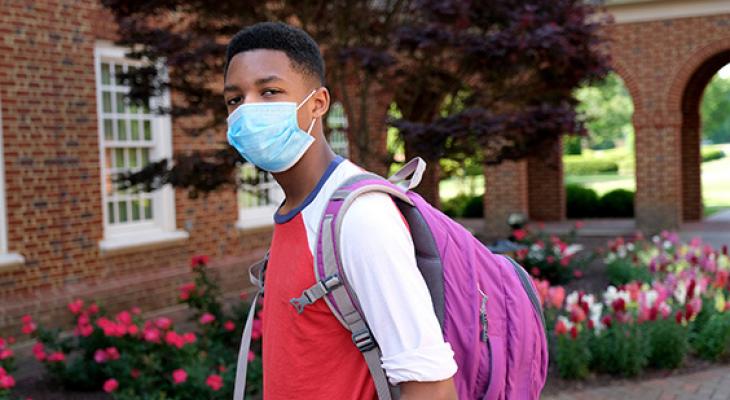Resources to Go Beyond the Basics and Support the Whole Child

As the summer winds down and the COVID-19 pandemic continues to complicate planning for the 2020-2021 school year, here’s what we know: Learning will take multiple forms, from in-person, to hybrid models, to full-time remote learning, and things will likely change as the school year progresses. As of early August, 17 of the 20 largest school districts in the U.S. have chosen remote learning only as their back-to-school instructional model, affecting more than 4 million students and their families and communities (see this feature in EdWeek for more details).
As educators, families and caregivers, and young people grapple with starting the school year a bit differently than they might have imagined, there is a growing consensus around the need to support the whole child and create positive conditions for learning. Research indicates that children learn best when they experience positive conditions for learning, which includes receiving emotional support from adults who can understand and respond to their needs, as well as engage in healthy developmental relationships.
Supporting the Whole Child as the New School Year Begins
Earlier this summer, AIR reviewed the national guidance around reopening and rebuilding efforts, and we noted an emphasis on supporting the whole child. Based on that finding, we wanted to learn more about how state education agencies are advising districts and schools on reopening, and, in particular, in their efforts to support the whole child. In our scan of the reopening guidance in all 50 states and the District of Columbia, we found that nearly all guidance included at least some discussion of whole child learning and development through brief mentions, lists of considerations or questions, and references to outside resources. The state guidance included such topics as social and emotional supports, school climate and conditions for learning, mental health and trauma, and community partnerships.
We noted four trends in the state reopening guidance:
- An emphasis on supporting whole child initiatives, especially for states that have already made significant investments in this area;
- A focus on the overall well-being of the school community;
- Encouragement or references to integrating whole child considerations into multi-tiered systems of support; and
- The need to work with community-based providers to offer mental health and other wraparound services to students and families and afterschool programs to deliver out-of-school supports that address students’ social, emotional, and academic needs.
It is encouraging that so much of the national and state guidance acknowledges a need to focus on the whole child. We think this indicates an interest in going beyond the basics of reopening efforts that rightly focus on physical safety measures (i.e., distancing, hand-washing, and mask wearing) to create conditions for learning that enable the whole person—both young people and adults—to thrive.
Building Positive Conditions for Learning—Anywhere
How can educators, families, and caregivers turn this interest into action? When the pandemic began and schools began to close, we developed a resource for families and caregivers to help foster positive conditions for learning at home. It is important to note, however, that learning happens everywhere and the strategies we describe are applicable across settings and with all adults, from educators to families and beyond. To quickly recap, positive conditions for learning:
- Are best created by adults who are ready to support academic, social, and emotional learning. How can adults be ready physically, mentally, and emotionally to support young people learn at home? Here are a few ideas: focus on basic needs (nutrition, sleep, and exercise); set realistic goals and expectations; be kind to yourself; and engage in activities that bring you joy. Education leaders from state education agencies, districts, and schools play a role in this, too, and can take this opportunity to consider how they can support adults to ensure their readiness.
- Are characterized by physical and emotional safety and support—both emotional support and learning support. Emotions trigger responses in our brain that affect how we feel and behave, and these emotions have a powerful effect on learning. When we feel emotionally safe—that is, when we feel calm, happy, and supported—our brains can more easily take in information, learn new things, and be productive. This is a good time for education leaders to examine how adults and youth experience warmth, empathy, and encouragement to learn new things, in new settings (at home), and in new ways (potentially without an in-person educator).
- Foster active engagement in learning. Young people often think of homework as a chore, and now that all schoolwork is “homework,” that feeling might be intensified. However, learning at home can provide opportunities to learn in a new way—to spark interests, creativity, excitement, and fulfilling engagement. Education leaders can help in this effort by exploring new and innovative ways to make the learning active, relevant, and fun.
Resources to Go Beyond the Basics and Support the Whole Child
Going beyond the basics to create safe and supportive opportunities for learning, connection, and thriving can be everyone’s responsibility, from parents, to teachers, to community members. To learn more about building positive conditions for learning, including tools and resources with strategies, access:
- Building Positive Conditions for Learning at Home: Strategies and Resources for Families and Caregivers, from AIR
- COVID-19 and Whole Child Efforts, a summary of national and state reopening guidance from AIR
- Social and Emotional Learning (SEL) Roadmap for Reopening School, from the Collaborative for Academic, Social, and Emotional Learning (CASEL)
- Education Leadership in the Time of COVID: Six Priority Actions from the Science of Learning and Development from the Science of Learning and Development Alliance
- Recognizing the Role of Afterschool and Summer Programs and Systems, from AIR
- Thriving, Robust Equity, and Transformative Learning & Development: A More Powerful Conceptualization of the Contributors to Youth Success, from the Readiness Projects, a joint effort led by the Forum for Youth Investment, the National Urban League, and AIR
This In the Field piece is part of a content series developed for the Innovation Hub at AIR. The Innovation Hub is a central platform that connects AIR experts, communities of practice (CoPs), and resources to support educators and members of the general public as they navigate instructional challenges related to the COVID-19 global pandemic.
